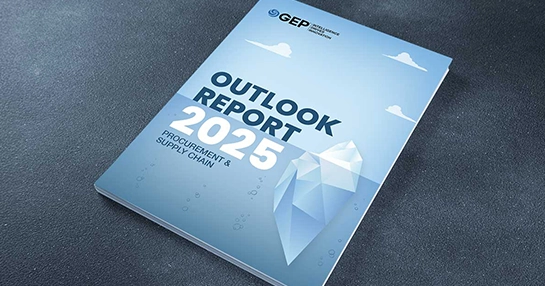
From Reactive to Proactive: How Predictive Analytics Can Be a Game-Changer for Procurement in 2025
- Forecast market shifts and disruptions by leveraging predictive analytics and scenario planning to stay ahead of evolving trends.
- Mitigate hidden multi-tier supply risks by identifying vulnerabilities and addressing issues before they impact operations.
- Optimize contracts through continuous performance monitoring, strategic renegotiation and stronger supplier collaboration.
February 25, 2025 | Procurement Strategy
As procurement leaders, you may have already deployed AI and predictive analytics to automate routine processes, streamline operations, and optimize costs. The real question now is: how do you go beyond foundational solutions to unlock exponential strategic value in 2025 and beyond?
To maintain competitive advantage, forward-thinking leaders must harness advanced AI capabilities to transform procurement from a reactive function to a proactive force driving business growth, resilience, and innovation.
Where We Are Now: The AI-Driven Procurement Landscape
Many organizations have implemented the "table stakes" solutions for procurement modernization, including:
• Automated Invoice Processing
Reduced manual errors and improved cycle times.
• Basic Spend Analysis
Identifying historical cost-saving opportunities.
• Supplier Risk Monitoring (Tier 1)
Tracking supplier stability and compliance metrics.
These capabilities provide a solid foundation but fall short of delivering true competitive differentiation. The strategic leap comes when you integrate predictive analytics and AI across decision-making processes to drive. foresight, agility, and continuous improvement.
Strategic Applications for Predictive Analytics
1. Predictive Market Intelligence: From Reactive to Proactive Decision-Making
Most procurement teams rely on past data to assess market trends, a reactive approach that limits agility. Predictive analytics transforms this model by enabling businesses to anticipate market shifts and plan proactively. By analyzing vast datasets, such as social media sentiment, geopolitical developments, and alternative economic indicators, AI can forecast fluctuations in commodity prices, material shortages, and regulatory risks.
This intelligence supports scenario planning, where businesses model “what-if” situations to prepare for disruptions before they materialize. For instance, predictive models might signal rising metal prices due to geopolitical unrest, prompting early renegotiation of sourcing contracts. Some organizations have successfully used this approach to mitigate the financial impact of carbon taxation policies by proactively adjusting their sourcing strategies.
2. Thorough Supplier Risk Management
Traditional risk management often focuses solely on direct suppliers, overlooking risks buried deeper in the supply chain. Predictive analytics provides greater visibility by mapping and continuously monitoring multi-tier supplier networks, identifying dependencies and vulnerabilities at Tier 2 and Tier 3 levels.
AI-driven insights can flag emerging risks, such as financial instability, environmental hazards, or geopolitical threats, allowing companies to act before these risks escalate. This proactive approach proved invaluable during the pandemic, as companies with advanced supplier mapping identified at-risk components and suppliers early and avoided significant supply disruptions.
3. Dynamic Contract Optimization
Contract management typically involves periodic reviews, limiting a company’s ability to capture real-time opportunities. Predictive analytics changes this by continuously monitoring contract performance, identifying deviations from terms, and uncovering unused service agreements. This allows procurement teams to act swiftly and renegotiate contracts under favorable conditions.
AI models analyze supplier performance and market dynamics to recommend optimal renegotiation windows, securing better terms for the business. By integrating AI-driven contract analytics with sourcing strategies, companies can maximize value over time.
4. Hyper-Personalized Supplier Collaboration
Building strong supplier relationships is critical for maintaining a competitive edge. Predictive analytics enables a more personalized and proactive approach to supplier management by offering granular performance insights rather than relying on static scorecards.
Early detection of declining supplier performance, such as delivery delays or quality issues, allows procurement teams to resolve issues before they escalate. Additionally, you can build strategic partnerships by co-developing innovation projects, leveraging AI-generated data insights to benefit both parties.
5. Generative AI-Powered Procurement
Generative AI is revolutionizing procurement by automating knowledge-intensive tasks and enhancing decision-making. Procurement teams can use this form of AI to draft RFPs, summarize proposals, and generate competitive bids, significantly reducing administrative workloads.
Advanced AI chatbots further streamline operations by handling complex supplier queries, offering procurement insights, and even supporting contract negotiations. Generative AI tools can instantly generate alternative supplier bids based on custom parameters, expediting the sourcing process and driving operational efficiencies.
By adopting predictive analytics and generative AI, procurement organizations can transform their processes and make strategic, data-driven decisions that yield long-term value and competitive advantage.
Also Read: Leveraging Predictive Analytics in Procurement
Turning Insight into Action: Practical Steps for Procurement Leaders
To realize the full potential of advanced predictive analytics, procurement leaders should focus on three key areas:
1. Technology Investments
Choose AI platforms purpose-built for procurement, capable of integrating with existing systems and offering predictive analytics, supplier mapping, and dynamic contract management.
2. Data Literacy and Talent Development
Empower your procurement team to understand, interpret, and act on AI-driven insights. Invest in upskilling and cross-functional collaboration.
3. Cultural Shift Toward Experimentation
Encourage a mindset that embraces experimentation and iterative learning, allowing your team to continuously explore and adopt new technologies.
Also Read: Don't Make These Mistakes When Adopting AI in your Supply Chains
Building the Predictive Procurement Function of the Future
The future belongs to procurement teams that move beyond basic AI capabilities and fully embrace predictive analytics. By anticipating market changes, mitigating supply chain risks, and optimizing contracts in real time, you can transform procurement into a proactive, strategic function that drives business growth and resilience.
Discover how GEP can help you unlock the full potential of AI and predictive analytics.



